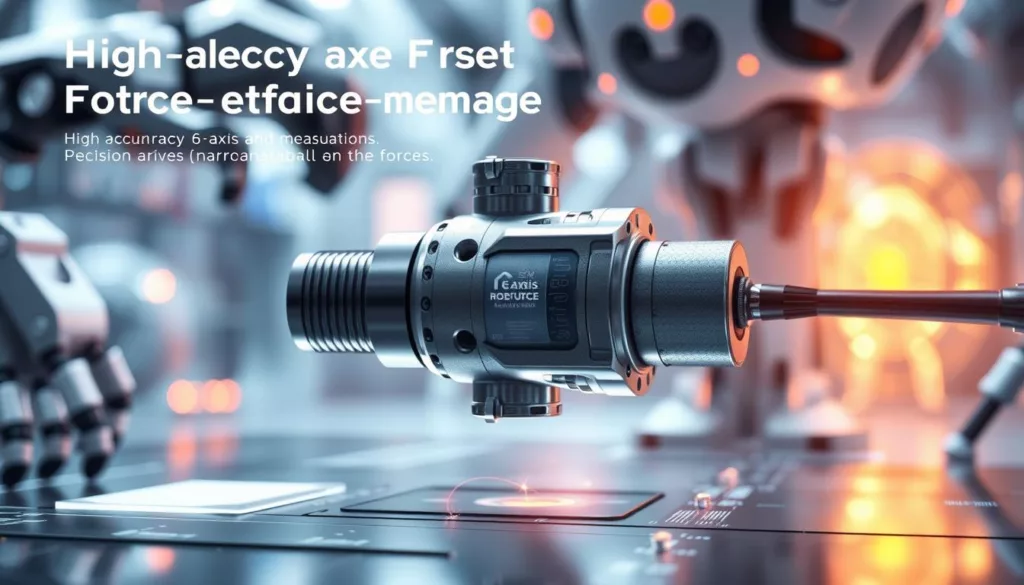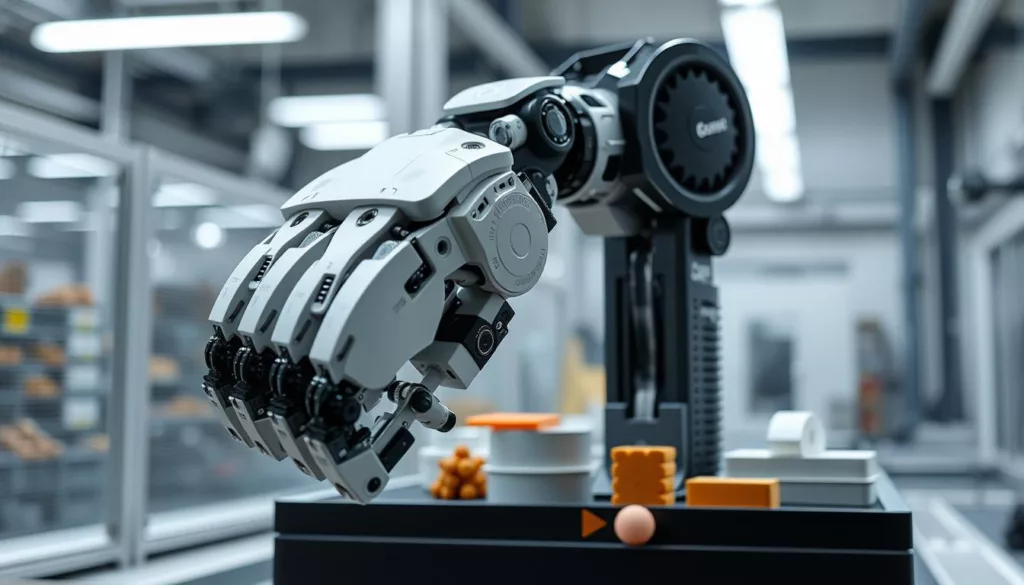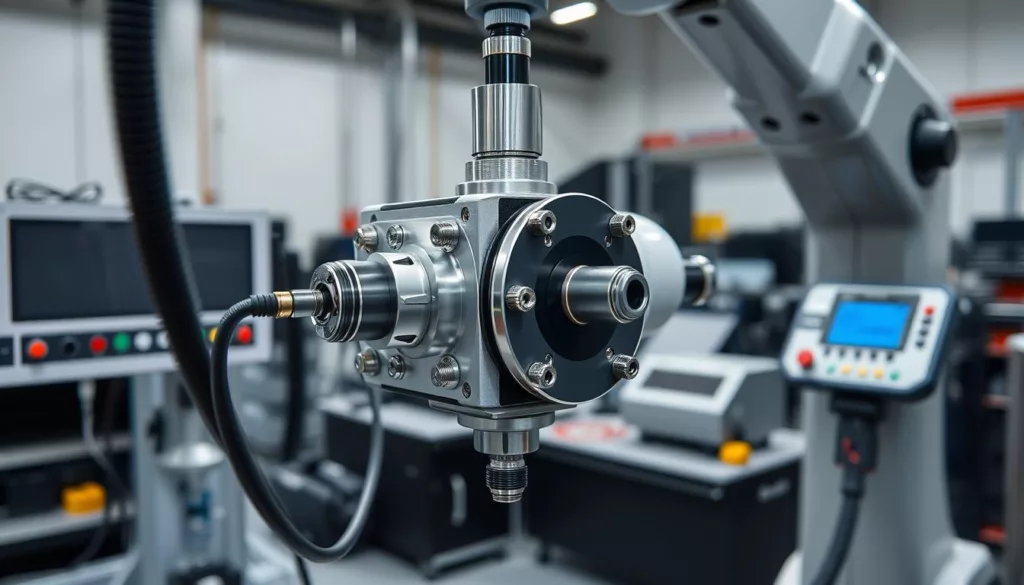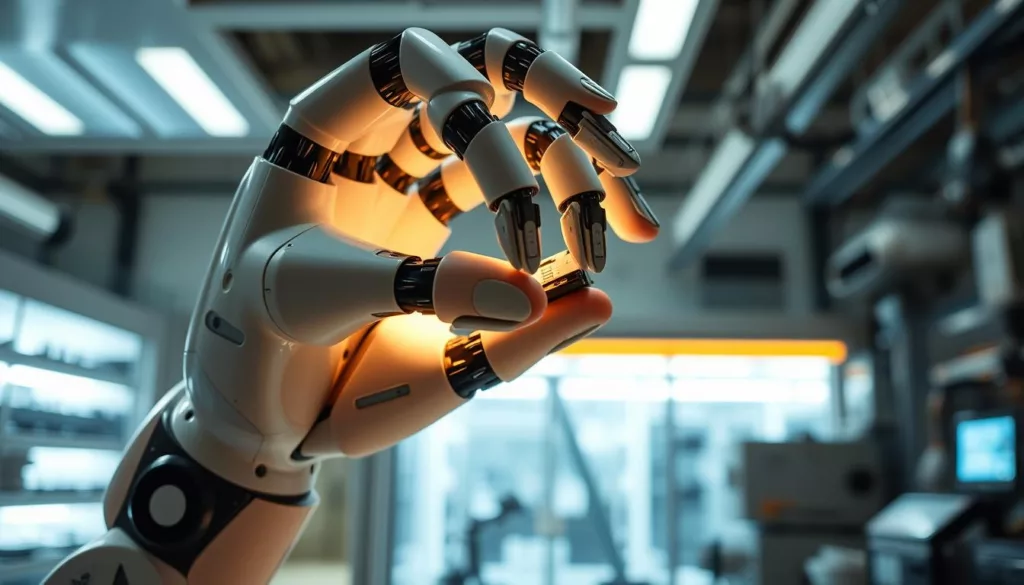The robotics world is growing fast, and precise force and torque measurement is key. The XJCSENSOR 6 axis force torque sensor is a top choice for today’s robots. It gives robots accurate, real-time data on forces and torques, helping them work better and safer.
The XJCSENSOR 6 axis force torque sensor is a big step up in robotics tech. It uses advanced tech to measure forces and torques in all directions. This lets robots do complex tasks with great precision and safety.
Key Takeaways
- XJCSENSOR’s high-accuracy 6 axis force torque sensor enables precise force and torque measurement for advanced robotic applications
- The sensor’s multi-axis measurement boosts robotic control, performance, and safety in many tasks
- Its advanced design and tech give real-time data with high accuracy and sensitivity
- The sensor’s design makes it easy to use with robots, adding to its value
- XJCSENSOR leads in precision, innovation, and expertise in robotics sensors
Understanding Force Torque Sensing in Modern Robotics
In the fast-changing world of robotics, it’s key to accurately measure and control forces. Robotic force control, made possible by advanced multi-axis load cells, is vital for dexterous robotic manipulation. Knowing how multi-axis force measurement works opens up new chances for precise robotic tasks.
Basic Principles of Multi-Axis Force Measurement
Force torque sensing lets us measure forces and moments on a robotic system in many directions. This is done with multi-axis load cells that use strain gauges to detect force components. This precise mapping lets robotic systems adapt and respond with unmatched precision, making tasks like surface following and delicate part mating possible.
Role of Sensors in Robotic Control Systems
Sensors are key in robotic control systems, giving real-time feedback on forces and torques. This info is vital for robotic force control algorithms. It lets the robot move through complex spaces, apply the right force, and do dexterous tasks with unmatched accuracy.
Evolution of Force Sensing Technology
Force sensing tech has grown a lot over time, thanks to better materials, electronics, and signal processing. Today’s multi-axis load cells are more precise, sensitive, and quick, letting robots interact with their environment more skillfully. As the need for dexterous robotic manipulation grows, so does the need for accurate force torque sensors, driving innovation in robotics.
“The ability to precisely measure and control forces is the foundation for unlocking the full robotic systems.”
High-accuracy 6 axis force torque sensor for robotic applications
At the heart of advanced robotic systems are 6 axis force torque sensors. These sensors are key for precise compliant robot end-effectors and force-controlled assembly. They measure forces and torques in all directions, giving robots a new level of control.
The main benefits of 6 axis force torque sensors in robotics are:
- They measure forces and torques in all three directions (X, Y, Z)
- They detect small changes in force and torque, enabling haptic feedback in robotics
- They make robots more compliant and responsive for delicate tasks
- They improve force control for tasks like material handling and part mating
| Feature | Benefit |
|---|---|
| Multi-axis force/torque measurement | Enables advanced robotic capabilities like compliant end-effectors and force-controlled assembly |
| High accuracy and resolution | Precise control and monitoring of forces for delicate tasks |
| Compact, modular design | Seamless integration with a variety of robotic platforms and end-effectors |
By using these 6 axis force torque sensors, robots can do more. They can be more dexterous, responsive, and controlled. This opens up new possibilities in industrial automation and more.
Key Components and Design Architecture
At the heart of 6 axis force torque sensors are key parts that work together. They give robots the exact force and torque they need. Each part is vital for the sensor’s success in giving robots the precise data they need.
Strain Gauge Configuration
The sensor’s design captures forces and torques from all directions. It uses special strain gauges placed and set up with care. This setup lets the sensor catch even the smallest changes in force, giving robots the data they need to work well.
Signal Processing Units
Signal processing units work with the sensor’s gauges to turn raw data into useful info. They use smart algorithms to remove noise and speed up responses. This means robots can sense forces accurately in real-time, helping with many tasks in industrial automation.
Mechanical Integration Elements
The sensor’s mechanical parts, like the housing and mounts, are made for a strong bond with robots. They make sure the sensor stays steady and reliable, even in tough industrial settings.
“The key to unlocking the full potential of intelligent robotic grippers lies in the sensor’s ability to deliver precise, real-time force and torque data. XJCSENSOR’s innovative design and engineering expertise are at the forefront of this critical technology.”
Precision Measurement Capabilities and Specifications
High-accuracy 6 axis force torque sensors for robotic applications are all about precise measurement. These advanced sensors are made to perform at the highest level. They come with technical specs that fit perfectly with the needs of robotic force control.
These high-accuracy 6 axis force torque sensors can measure a lot. They can detect forces and torques in multiple directions. They can handle up to 1000 Newtons of force and 100 Newton-meters of torque, making them ready for tough robotic tasks.
They also have a high level of resolution and accuracy. These sensors can spot changes in force and torque as small as 0.01 Newtons and 0.001 Newton-meters. Plus, they can be accurate up to 0.5% of the full scale. This means they can provide reliable and consistent measurements for your robotic force control needs.
| Specification | Range | Resolution | Accuracy |
|---|---|---|---|
| Force (X, Y, Z) | ±1000 N | 0.01 N | ±0.5% FS |
| Torque (Tx, Ty, Tz) | ±100 N·m | 0.001 N·m | ±0.5% FS |
These sensors stand out because of their top-notch performance. They have a strong design and advanced signal processing. This makes them a top pick for many robotic tasks, like assembly, quality control, material handling, and more.
Applications in Industrial Automation
High-accuracy 6 axis force torque sensors are key in today’s industrial automation. They boost precision and efficiency in many manufacturing tasks. These sensors are changing how industries handle important tasks, from force-controlled assembly to dexterous robotic manipulation and intelligent robotic grippers.
Assembly Line Operations
In assembly lines, 6 axis force torque sensors help with precise part fitting. They control the assembly process finely. This ensures products are made consistently and waste is reduced.
Quality Control Processes
Manufacturers use these sensors for better quality control. They measure small changes in force and torque. This helps spot defects early and improve product quality.
Material Handling Systems
In material handling, these sensors are vital. They help with dexterous robotic manipulation and intelligent robotic grippers. They give robots feedback on forces and torques. This lets them handle fragile materials carefully, reducing damage and improving efficiency.
“The integration of 6 axis force torque sensors has revolutionized the way we approach industrial automation, empowering our teams to achieve new levels of precision and efficiency.”
Integration with Robotic End-Effectors
Advanced robotics gets a boost with high-accuracy 6-axis force torque sensors. These sensors make robotic systems more compliant and dexterous. They also improve haptic feedback in robotics.
These sensors are key to precise force and torque monitoring in robotic end-effectors. This lets robots adjust their actions and grip strength. They can handle delicate tasks with great care.
Robotic grippers can now adjust their grip strength on the fly. This is super useful in assembly, quality checks, and material handling. It ensures parts are handled safely and consistently.
| Robotic Application | Benefits of Force Torque Sensor Integration |
|---|---|
| Assembly Line Operations | Precise part mating, reduced part damage, improved production efficiency |
| Quality Control Processes | Accurate product testing, consistent force application, enhanced process monitoring |
| Material Handling Systems | Gentle object manipulation, optimized grip force, enhanced safety and reliability |
With these sensors, robotic end-effectors become more dexterous and precise. This changes how robots interact with their environment. They can now perform complex tasks with unmatched precision and control.
Force-Controlled Assembly Operations
In today’s robotics, 6 axis force torque sensors are key for precise assembly. They give the feedback needed for accurate part fitting and smooth surface following in complex tasks.
Precise Part Mating
Robots need accurate force/torque measurement for delicate part fitting. With 6 axis sensors, they can control the force applied. This ensures a secure and repeatable connection without damaging fragile parts.
This is very important in electronics manufacturing. Here, small parts need a careful yet firm assembly.
Surface Following Applications
- Robots with 6 axis sensors can follow surfaces well. They keep the right contact pressure and avoid collisions.
- This is key in car body panel installation. Robots must fit parts with complex shapes smoothly.
- The detailed force/torque data lets robots adjust in real-time. This ensures a precise, repeatable, and safe assembly.
Using advanced 6 axis force torque sensors, manufacturers can improve their assembly work. This leads to more accurate, efficient, and reliable production.
Calibration and Maintenance Protocols
Keeping a high-accuracy 6 axis force torque sensor for robotic applications in top shape is key. At XJCSENSOR, we’ve created a detailed plan for calibration and upkeep. This ensures our precision force/torque measurement tools stay reliable and consistent over time.
It’s vital to calibrate multi-axis load cells regularly. This helps them stay accurate by adjusting for any changes. Our calibration steps include:
- Regular recalibration with certified tools and methods
- Keeping detailed records of performance before and after calibration
- Adjusting sensor settings to meet exacting standards
Preventive care also plays a big role in extending the life of our sensors. This includes:
- Checking for physical damage or wear during routine checks
- Cleaning and protecting the sensors from dirt and moisture
- Replacing parts like cables and connectors as needed
If problems do come up, our skilled team is ready to help. They’ll guide you through troubleshooting to find and fix issues fast. With our maintenance and calibration steps, your XJCSENSOR force torque sensor will keep giving you precise readings for many years.
“The calibration and maintenance protocols from XJCSENSOR have been instrumental in keeping our robotic assembly lines running at peak performance.”
– *Manufacturing Engineer, ABC Robotics*
Real-time Data Processing and Feedback Systems
In robotics, force torque sensing is key for precise control. Advanced data processing and feedback systems are at the core. They help robots make quick, smart decisions.
These systems use advanced techniques like signal filtering and response time optimization. They unlock the full power of robotics force sensing, haptic feedback in robotics, and intelligent robotic grippers.
Signal Filtering Methods
Getting accurate force and torque measurements is tough. It’s because of the noise in sensor data. Our team has created smart signal filtering algorithms.
These algorithms get rid of the noise, keeping the important force and torque info. This means robots get clear feedback. They can then act fast and accurately.
Response Time Optimization
Robots need to react quickly for smooth operations. Our 6-axis force torque sensors are designed for fast signal processing and data transmission. This cuts down on delay, giving robots real-time feedback.
This fast feedback lets robots control themselves precisely. They can quickly adjust to changes in force and torque. This makes robots very agile and responsive.
Our systems combine fast response times with advanced signal processing. This boosts the performance of robotics force sensing. It opens up new possibilities for industries looking to automate and improve precision.
Advanced Features for Complex Operations
The need for dexterous robotic manipulation and force-controlled assembly is rising. High-accuracy 6 axis force torque sensors are now capable of handling complex tasks. They are changing what’s possible in automation, making robots more versatile and precise.
These sensors can sense forces at multiple points. This lets them understand the forces on the robot’s end-effector in detail. This info helps robots do complex tasks with great skill and compliant robot end-effectors.
Also, new algorithms and machine learning are making force-controlled assembly better. Robots with these sensors can adjust their actions in real time. This ensures they can fit parts together perfectly, even when things change or get unexpected.
| Feature | Benefit |
|---|---|
| Multi-point Force Sensing | Comprehensive force and torque distribution data for enhanced control and dexterity |
| Adaptive Force Control | Precise part mating and surface following capabilities for complex assembly tasks |
| Machine Learning Integration | Intelligent decision-making and optimization of robotic operations |
These advanced features, along with the sensor’s accuracy and reliability, are changing how robots handle complex tasks. By working with robotic end-effectors and control systems, high-accuracy 6 axis force torque sensors are leading the next big steps in industrial automation.
Future Developments and Emerging Technologies
The need for high-accuracy 6 axis force torque sensors in robotics is rising. Experts are looking into new technologies to improve this field. They see artificial intelligence (AI) as a key area to explore.
AI could bring more precision, flexibility, and smarts to robots. This could change how robots work and interact with their environment.
AI Integration Possibilities
AI could make robots smarter by using machine learning. This would let robots make quick decisions based on what they sense. It could lead to robots that can adjust how they grip things based on the task.
Next-Generation Sensor Materials
Scientists are also working on new materials for sensors. They’re looking at graphene and piezoelectric ceramics. These could make sensors smaller, more sensitive, and last longer.
This could help create the next generation of robots. Robots that are smarter, more precise, and can handle tasks better than before.





